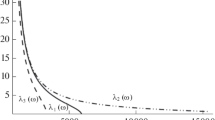Abstract.
The problem of an electric point charge moving constantly along the poling direction of a transversely isotropic piezoelectric solid is considered in a moving coordinate system, which moves together with the electric point charge. A general solution in the moving coordinate system is given, and all the field components, such as displacements, electric potential, stresses and electric displacements, can be concisely expressed in terms of four quasi-harmonic functions. We also present two examples to demonstrate the effect of the moving velocity on the values of λ i . Once the general solution is given, the axisymmetric problem of a moving electric point charge can be easily solved. The explicit expressions of all the field components caused by the moving electric charge are presented, and the effect of the moving velocity on these field components is numerically investigated.
Similar content being viewed by others
References
Ding, H.J.: Transversely isotropic elasticity. Zhejiang University Press, Hangzhou (1997) (in Chinese)
Ding, H.J.; Chen, B.; Liang, J.: General solutions for coupled equations for piezoelectric media. Int J Solids Struct 33 (1996) 2283–2298
Ma, X.K.: Electromagnetic theory and its application. Xi’an Jiaotong University Press, Xi’an (1997) (in Chinese)
Pak, Y.E.: Force on a piezoelectric screw dislocation. ASME J Appl Mech 57 (1990) 863–869
Pan, E.: Exact solution for simply supported and multilayered magneto-electro-elastic plates. ASME J Appl Mech 68 (2001) 608–618
Reddy, J.N.; Cheng, Z.Q.: Three-dimensional solutions of smart functionally graded plates. ASME J Appl Mech 68 (2001) 234–240
Ru, C.Q.: Eshelby’s problem for two-dimensional piezoelectric inclusions of arbitrary shape. Proc R Soc Lond A 456 (2000) 1051–1068
Suo, Z.; Kuo, C.M.; Barnett, D.M.; Willis, J.R.: Fracture mechanics for piezoelectric ceramics. J Mech Phys Solids 40 (1992) 739–765
Wang, B.: Three-dimensional analysis of an ellipsoidal inclusion in a piezoelectric material. Int J Solids Struct 29 (1992) 293–308
Wang, X.; Zhong, Z.; Wu, F.L.: A moving conducting crack at the interface of two dissimilar piezoelectric materials. Int J Solids Struct 40 (2003) 2381–2399
Wang, Z.K.; Huang, S.H.: Fields near elliptical crack tip in piezoelectric ceramics. Eng Fract Mech 51 (1995) 447–456
Zhao, M.H.; Shen, Y.P.; Liu, Y.J.; Liu, G.N.: Isolated crack in three-dimensional piezoelectric solid: part I–solution by Hankel transforms. Theor Appl Fract Mech 26 (1997) 129–139
Author information
Authors and Affiliations
Corresponding author
Rights and permissions
About this article
Cite this article
Wang, X. An electric point charge moving along the poling direction of a transversely isotropic piezoelectric solid. Arch Appl Mech 74, 509–516 (2005). https://doi.org/10.1007/s00419-005-0372-y
Received:
Accepted:
Issue Date:
DOI: https://doi.org/10.1007/s00419-005-0372-y




